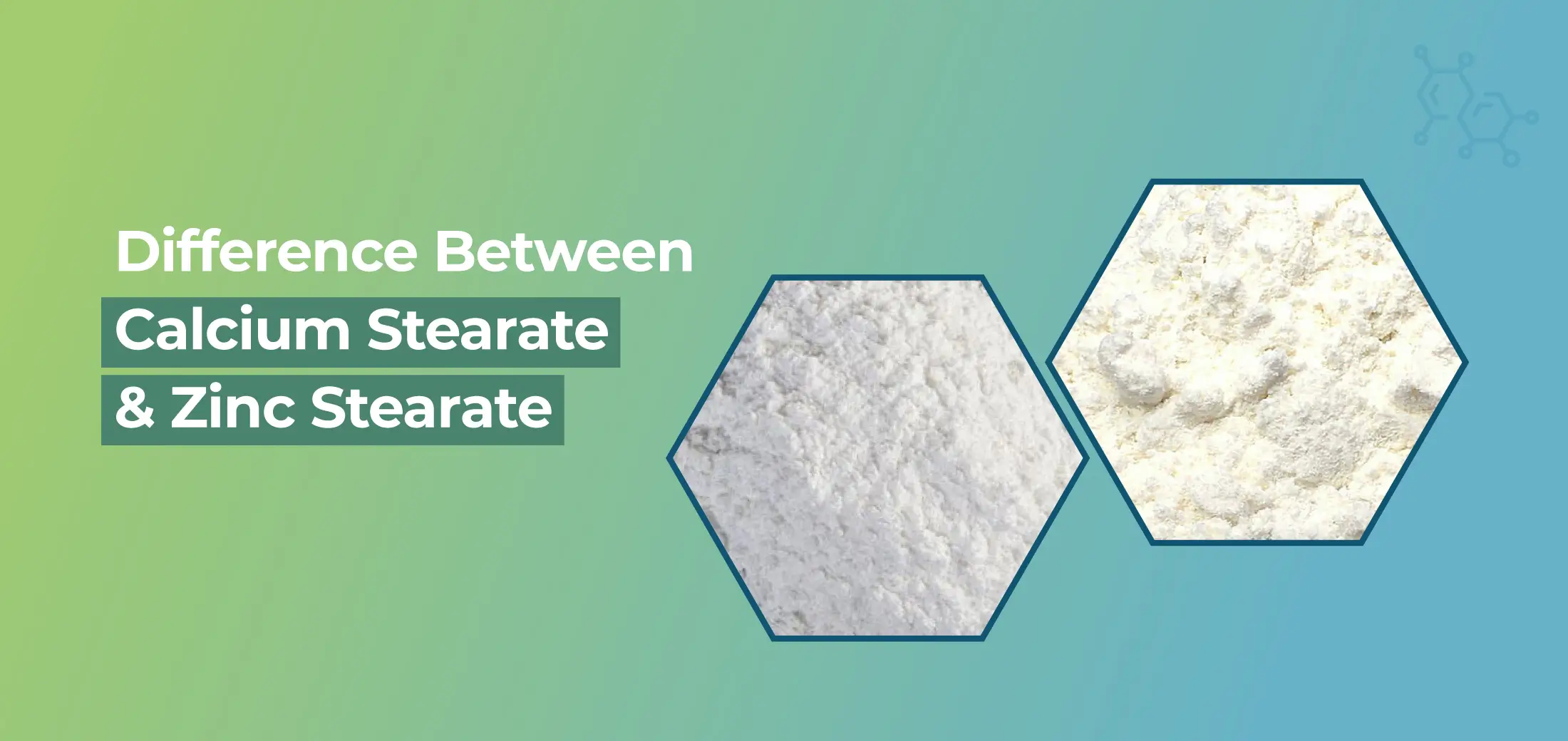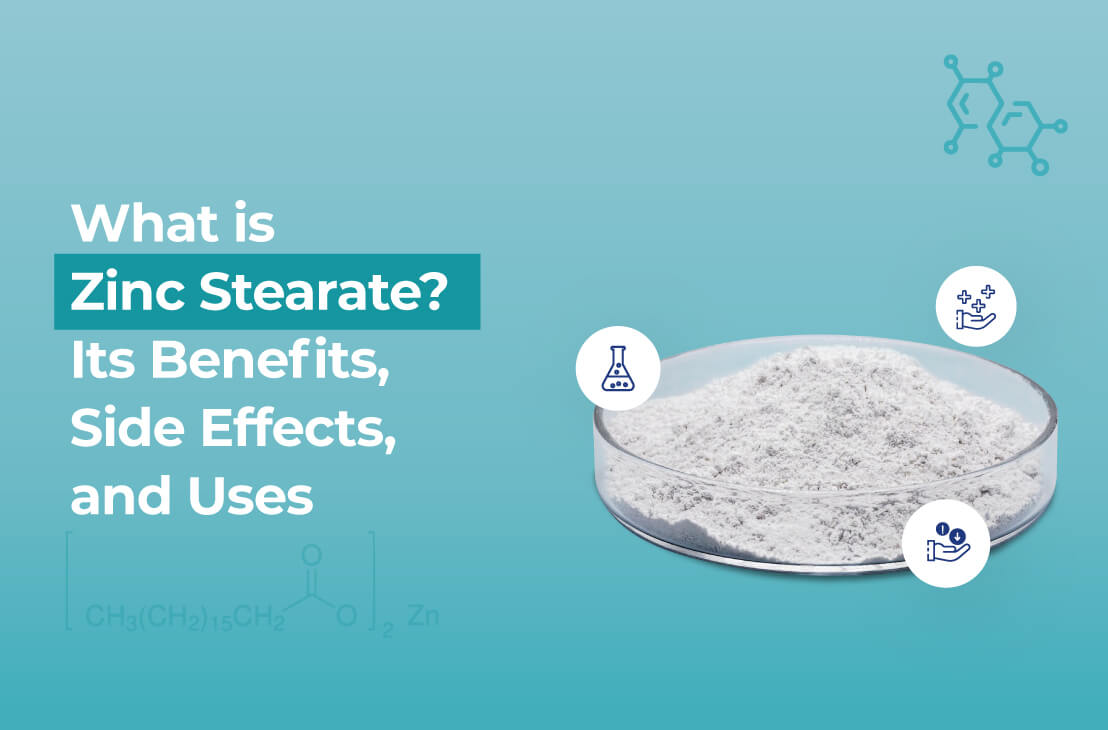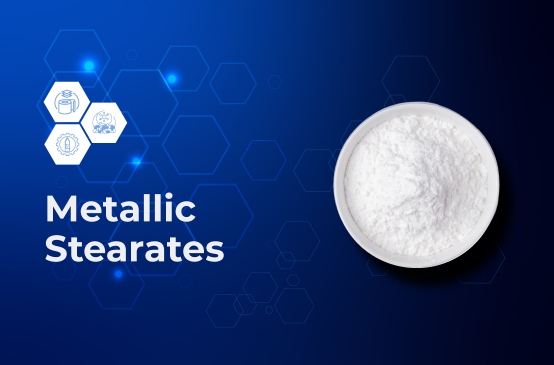Small ingredients can make a big difference in the world of industrial manufacturing. Calcium stearate and zinc stearate are two of the crucial ingredients. These ingredients are a part of various products, which help them mold smoothly. Manufacturers extensively use calcium and zinc stearates to achieve a dry and flawless finish.
While both these ingredients are derived from stearic acid and share similar appearances, they have distinct roles to play in different environments. Choosing the wrong ingredient results in poor surface quality, lower cycle times, and even regulatory hurdles.
In this guide, we have comprehensively explained how calcium stearate differs from zinc stearate.
Basic Chemical Overview of Calcium Stearate and Zinc Stearate
Both calcium stearate and zinc stearate are metallic salts derived from stearic acid, a saturated fatty acid commonly obtained from plant or animal fats. These compounds come under the category of metal soaps. They find an extensive application in plastics, rubber, pharmaceuticals, and cosmetics due to their lubricating, stabilizing, and release properties.
Although calcium stearate and zinc stearate share a similar origin, their chemical structure and physical behaviors vary enough to impact the overall performance. Generally, calcium stearate is used in applications where thermal stability and mild lubricity are vital.
On the other hand, zinc stearate is used in applications that require excellent mold release and smooth surfaces.
Let's take a look at the basic properties of calcium stearate and zinc stearate in the table below.
| Property | Calcium Stearate | Zinc Stearate |
|---|---|---|
| Appearance | White powder or flakes | White, fine, hydrophobic powder |
| Melting Point | ~150°C | ~120 to 130°C |
| Solubility | Insoluble in water, soluble in oils | Insoluble in water and slightly soluble in alcohol |
These basic differences affect how each stearate behaves during processing and how it performs in the end product.
Industrial Applications of Calcium Stearate And Zinc Stearate
Now, we'll take a look at the industrial applications of these two ingredients.
-
Calcium Stearate
Calcium stearate is known for its thermal stability and compatibility with PVC. These properties make this stearate a favourable choice for:
- PVC heat stabilizers in pipes, profiles, and cable insulation
- Cement additives to reduce water absorption and improve functioning
- Pharmaceutical tablets, acting as a lubricant during compression
- Certain food-grade applications, where it meets regulatory approvals as a flow agent
Its cost-effectiveness and ease of incorporation also make it a preferred additive in large-scale industrial formulations.
-
Zinc Stearate
- Zinc stearate is primarily used where surface finish and mold release are crucial. It is used:
- As a mold release agent in injection-moulded plastics and elastomers
- In coatings and paints as a flattening and anti-settling agent
- Within cosmetics, where it improves texture and feel in powders and creams
- As a dry lubricant in rubber processing, reducing friction and wear during molding
The hydrophobic nature of zinc stearate also makes it particularly useful in moisture-sensitive applications.
Common Industry Applications of Calcium Stearate and Zinc Stearate
| Industry | Calcium Stearate | Zinc Stearate |
|---|---|---|
| Plastics | Heat stabilizer | Mold release and lubricant |
| Rubber | Processing aid | Dry lubricant and mold release |
| Pharmaceuticals | Tablet flow agent | Tablet lubricant (less common) |
| Cosmetics | Anti-caking, binder | Texture and smoothness agent |
| Paints or Coatings | Matting agent (limited use) | Widely used as a flatting agent |
Functional Differences between Calcium Stearate And Zinc Stearate In Performance
When it comes to performance, calcium stearate and zinc stearate serve different strengths depending on the process and the product.
-
Thermal Stability
Calcium stearate is known for its high thermal resistance. This property makes it ideal for high-temperature processes like PVC extrusion and injection molding. It retains its structural integrity and works under extended heating conditions, thereby reducing degradation risk.
-
Lubrication and Mold Release
As a mold release agent, zinc stearate performs better than calcium stearate. Its excellent slip properties help in releasing molded parts cleanly and reduce friction between tooling surfaces and polymers. This property is particularly valuable in rubber, thermosets, and engineering plastics.
-
Compatibility with Polymers
Calcium stearate is widely compatible with PVC, HDPE, and polypropylene. It is often used as a co-stabilizer. Zinc stearate, on the other hand, is commonly blended with ABS, polystyrene, and polyamides, where surface smoothness is more important.
-
Impact on Appearance
Zinc stearate can influence optical clarity. It often reduces gloss or adds a matte finish in coatings. Calcium stearate has minimal impact on transparency, but it may leave slight residues if overused.
From this comparison, it's evident that calcium stearate offers better thermal resistance, while zinc stearate performs better in mold release and surface finish. Depending on the process and end-use priorities, manufacturers must choose the right ingredient.
Regulatory and Safety Aspects
In some industries, compliance is a crucial part of procurement decisions. Therefore, manufacturers must understand the regulatory aspects of the materials being used. Both calcium stearate and zinc stearate are well-established in global markets. They are generally recognized as safe when used within prescribed limits.
-
Calcium stearate
Calcium stearate is widely approved for use in food-contact applications and pharmaceuticals. It is listed in the GRAS (Generally Recognized as Safe) inventory of the FDA in the US and complies with European food additive regulations. Moreover, it's biodegradable and is considered safe for the environment when used in specified concentrations.
-
Zinc stearate
While zinc stearate is approved for certain applications, it is used more selectively in food and pharmaceutical sectors due to lower solubility and compatibility issues with the skin. However, it remains fully compliant with REACH and is widely used in industrial-grade formulations.
At Nimbasia Stabilizers, both these substances are produced under stringent heavy metal and contaminant restrictions. This makes them suitable for regulated manufacturing environments.
How to Choose the Right Stearate for Your Application?
Now that we have comprehensively discussed the properties and use cases of calcium and stearates, here's the final checklist for buyers while choosing the right one.
- Consider processing temperature
- Evaluate mold release and stability requirements
- Check for regulatory compliance in your target market
- Factor in cost and supply chain consistency
- Check the compatibility with polymers
- Understand their heat resistance
- Check out lubricity requirements
- Make sure they comply with regulatory guidelines
Source the Right Ingredient from Nimbasia Stabilizers for Your Formulation
Calcium and zinc stearates may look similar on paper, but their applications in the industry are different. So, it pays to know when to use each, which can improve product quality, reduce costs, and ensure compliance.
Partner with Nimbasia Stabilizers to source pure, industry-compliant stearates and get expert support tailored to your manufacturing standards.









